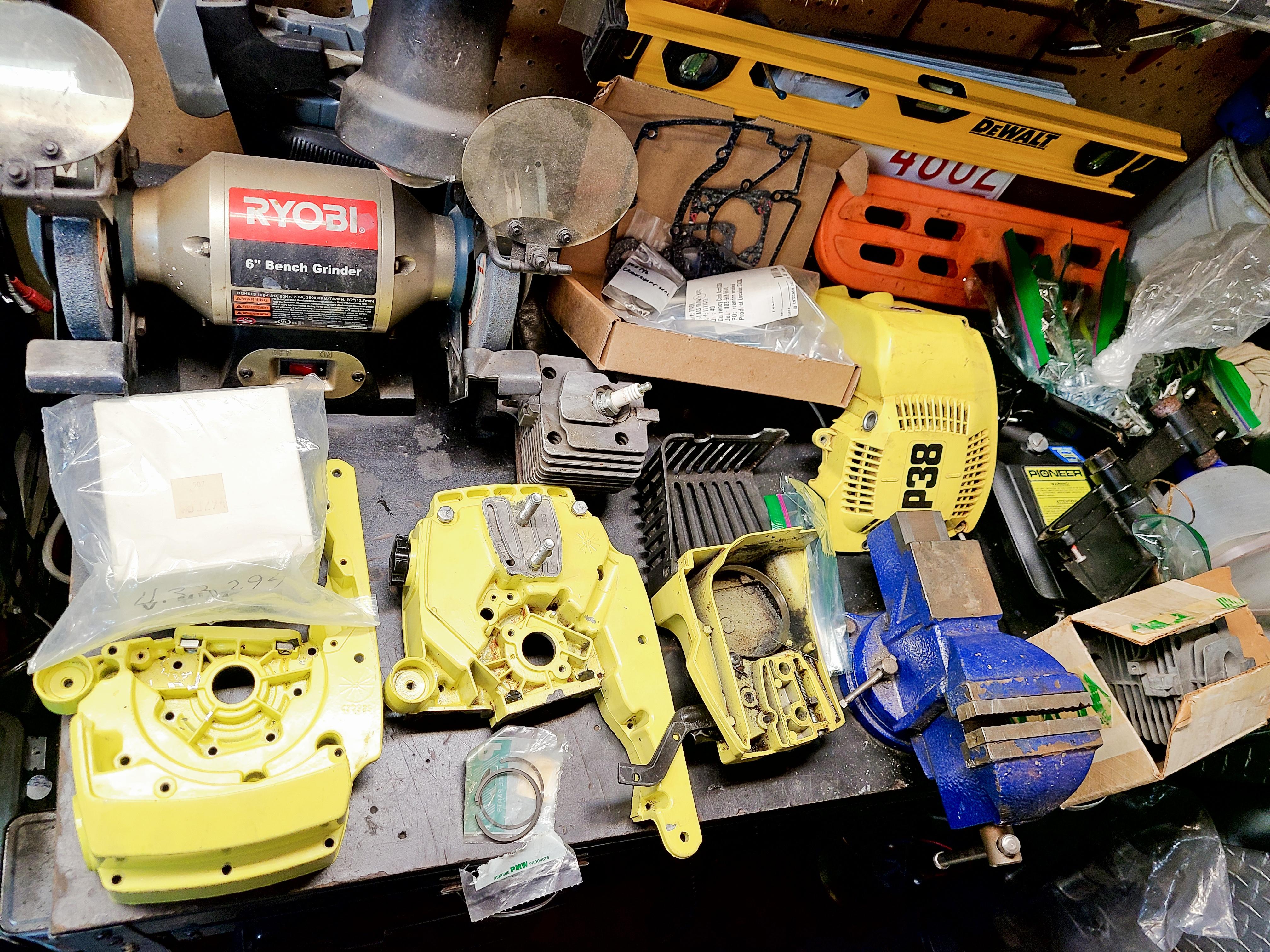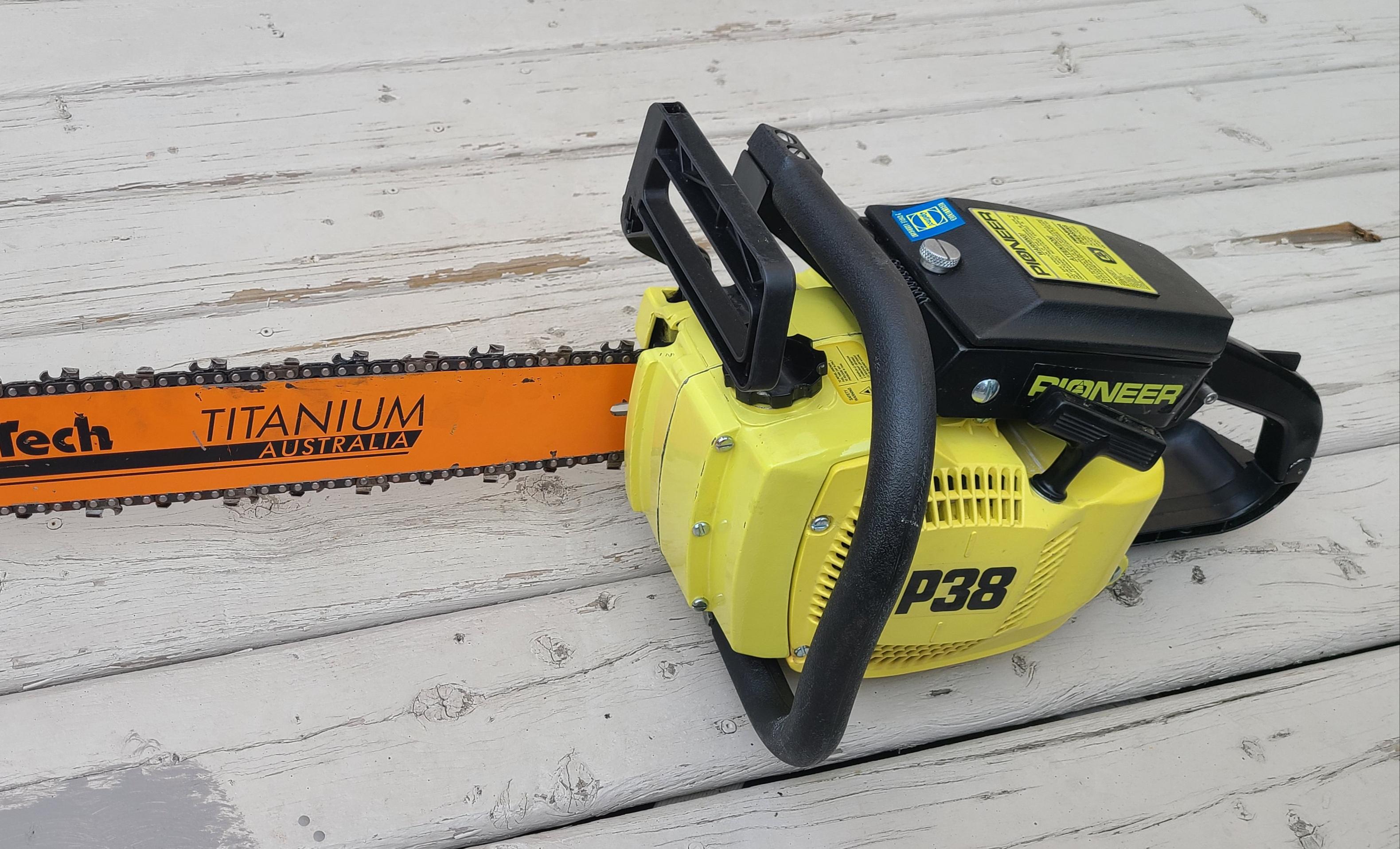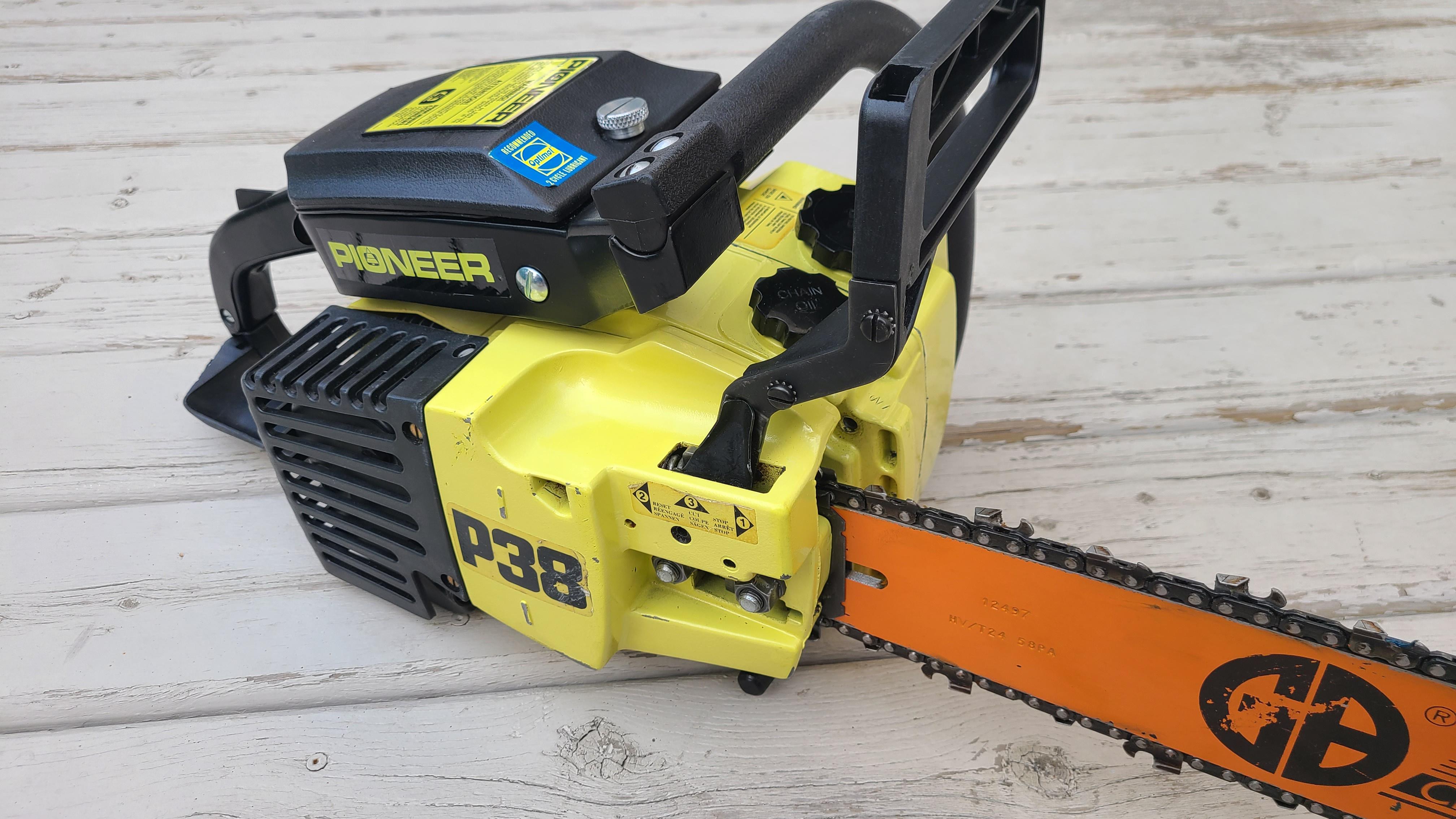CB:the saw had the original primer that didn"t work,so i replaced it with a wiper snipper primer bulb, seems to work great WRT starting .I tried all of your suggestions but didn't get any positive results.I also kitted the carb thinking that would cure the loading up at idle.as a last resort I'll do more fine tuning maybe that's my problem.Thanks again CB for all your help.It may be possible to plug the oiler inlet and outlet and get it to pass a vac test. I don't remember ever messing with that on my 1200A. There is a big plug on the back of the case for installing the oiler shaft and a pin with on oring that holds the oiler shaft in place laterally. The shaft itself could leak where it runs in the case bore, hence plugging the oiler ports. Plenty of older saws won't pass vac tests without isolating the oilers. That's their nature.
That said, for leaks I'd look hard at the reed valve gaskets. Those are the most likely source. This is a choke carb I assume? If it has a primer that could be another source of leaking. If the outlet check valves are bad, the primer will dribble fuel into the case constanly.
You are using an out of date browser. It may not display this or other websites correctly.
You should upgrade or use an alternative browser.
You should upgrade or use an alternative browser.
Pioneer chainsaws
- Thread starter WesternSaw
- Start date
-
- Tags
- operator manual

Help Support Arborist Forum:
This site may earn a commission from merchant affiliate
links, including eBay, Amazon, and others.
propliner
ArboristSite Guru
Regarding my earlier post with the 525 boost port cylinder and standard piston, I'm wondering if the piston pin needs to have the closed side towards the boost port. Would this cause it to lose compression? Is this the reason for the sealed pin? Mine is possibly installed backwards with the sealed side toward the exhaust. I will switch it around and reassemble.
propliner
ArboristSite Guru
All2surreal
ArboristSite Lurker
Hi,
I just inherited a Pioneer Holiday chainsaw. My dad had got it back in 1980. I was just given it this past Father's Day in 2023.
Currently it has a 22inch Windsor bar that has a 10 tooth replaceable sprocket, is .050 gauge and .404 pitch.
The chain is Oregon and has "50" printed on the drive links. When I looked up what this "50" meant, I see that it is a .404 pitch chain with .050 gauge. I also counted that it has 64 drive links.
The sprocket on the saw itself has 8 teeth.
It's my mission to modernize it now.
So far I have bought an Oregon 20inch, .050 gauge, 3/8 pitch, 72 drive link VersaCut bar that has a K095 bar mount pattern.
Item number: 200VXLHK095
Also, bought a matching Oregon PowerCut chain.
Item number: 72LPX072G
New Champion CJ8 spark plug.
Now the biggest problem is the sprocket. The current sprocket has nothing printed on it so I have no way to know for sure what part number it is, moreover, what pitch it is. Only thing I know is that it has 8 teeth! I have to believe it's a .404 pitch because of the matching bar and chain currently on it. However, I cannot find any reference to 8 teeth sprockets on the internet or eBay that are .404 pitch and related to Pioneer saws. Everything I found with .404 pitch has 7 teeth. I'm thinking that it is a 3/8 pitch sprocket as this is what's indicated as OEM from www.acresinternet.com
I have one major problem right now. HOW do I get the old sprocket off?
Any words of advice here and I'd be grateful.
Thanks, Adam
I just inherited a Pioneer Holiday chainsaw. My dad had got it back in 1980. I was just given it this past Father's Day in 2023.
Currently it has a 22inch Windsor bar that has a 10 tooth replaceable sprocket, is .050 gauge and .404 pitch.
The chain is Oregon and has "50" printed on the drive links. When I looked up what this "50" meant, I see that it is a .404 pitch chain with .050 gauge. I also counted that it has 64 drive links.
The sprocket on the saw itself has 8 teeth.
It's my mission to modernize it now.
So far I have bought an Oregon 20inch, .050 gauge, 3/8 pitch, 72 drive link VersaCut bar that has a K095 bar mount pattern.
Item number: 200VXLHK095
Also, bought a matching Oregon PowerCut chain.
Item number: 72LPX072G
New Champion CJ8 spark plug.
Now the biggest problem is the sprocket. The current sprocket has nothing printed on it so I have no way to know for sure what part number it is, moreover, what pitch it is. Only thing I know is that it has 8 teeth! I have to believe it's a .404 pitch because of the matching bar and chain currently on it. However, I cannot find any reference to 8 teeth sprockets on the internet or eBay that are .404 pitch and related to Pioneer saws. Everything I found with .404 pitch has 7 teeth. I'm thinking that it is a 3/8 pitch sprocket as this is what's indicated as OEM from www.acresinternet.com
I have one major problem right now. HOW do I get the old sprocket off?
Any words of advice here and I'd be grateful.
Thanks, Adam
Attachments
propliner
ArboristSite Guru
I love .404 setups because they throw those big chips. You should be able to remove the clutch by removing the nut and then pulling the clutch off the splines. I use an impact gun to make quick work of the nut but make sure you're going the right way! Some of those are reverse thread.Hi,
I just inherited a Pioneer Holiday chainsaw. My dad had got it back in 1980. I was just given it this past Father's Day in 2023.
Currently it has a 22inch Windsor bar that has a 10 tooth replaceable sprocket, is .050 gauge and .404 pitch.
The chain is Oregon and has "50" printed on the drive links. When I looked up what this "50" meant, I see that it is a .404 pitch chain with .050 gauge. I also counted that it has 64 drive links.
The sprocket on the saw itself has 8 teeth.
It's my mission to modernize it now.
So far I have bought an Oregon 20inch, .050 gauge, 3/8 pitch, 72 drive link VersaCut bar that has a K095 bar mount pattern.
Item number: 200VXLHK095
Also, bought a matching Oregon PowerCut chain.
Item number: 72LPX072G
New Champion CJ8 spark plug.
Now the biggest problem is the sprocket. The current sprocket has nothing printed on it so I have no way to know for sure what part number it is, moreover, what pitch it is. Only thing I know is that it has 8 teeth! I have to believe it's a .404 pitch because of the matching bar and chain currently on it. However, I cannot find any reference to 8 teeth sprockets on the internet or eBay that are .404 pitch and related to Pioneer saws. Everything I found with .404 pitch has 7 teeth. I'm thinking that it is a 3/8 pitch sprocket as this is what's indicated as OEM from www.acresinternet.com
I have one major problem right now. HOW do I get the old sprocket off?
Any words of advice here and I'd be grateful.
Thanks, Adam
propliner
ArboristSite Guru
I started the morning with this basket case. It was a P38 in bad shape and wouldn't run. The fuel tank was gummed up and the carb didn't work. It had a bunch of parts that didn't belong and it didn't run at all. I paid $145 Canadian dollars (about $100 USD) for the saw.

New parts included cylinder, rings, bearings, seals, coil, gaskets, carb, vibe buffers, flywheel, fuel lines, wiring and oil pump and ended the day with this, a good running saw.



New parts included cylinder, rings, bearings, seals, coil, gaskets, carb, vibe buffers, flywheel, fuel lines, wiring and oil pump and ended the day with this, a good running saw.


Attachments
All2surreal
ArboristSite Lurker
How do I keep the crankshaft from turning? The problem I have is soon as I attach a wrench to the nut which holds on the sprocket the crankshaft turns with the nut; either way too.I love .404 setups because they throw those big chips. You should be able to remove the clutch by removing the nut and then pulling the clutch off the splines. I use an impact gun to make quick work of the nut but make sure you're going the right way! Some of those are reverse thread.
gumneck
Addicted to ArboristSite
I usually: Pull the spark plug, insert 8-10 inches of clean 3/8 inch cord/rope into the cylinder(Clean means I never use this cord for anything but this purpose so it has not picked up any dirt or grit from using outside on the ground in some way).How do I keep the crankshaft from turning? The problem I have is soon as I attach a wrench to the nut which holds on the sprocket the crankshaft turns with the nut; either way too.
Once you have the cord in, you can rotate the crank a little and you will feel the resistance the cord provides. Remove nut.
All2surreal
ArboristSite Lurker
Alright. I have seen this technique on YouTube and I tried it last night with a shoestring but to no avail. I felt the resistance and started to work on it with a wrench but then it just seemed to push thru the shoestrings, albeit they were thin, and then not much resistance anymore. So, I feel that the shoestrings were too thin. I will try to get some 3/8 inch rope today. I think that is the next step and it should provide much more resistance. Thank you! If it doesn't work then I will have to cut the nut off.I usually: Pull the spark plug, insert 8-10 inches of clean 3/8 inch cord/rope into the cylinder(Clean means I never use this cord for anything but this purpose so it has not picked up any dirt or grit from using outside on the ground in some way).
Once you have the cord in, you can rotate the crank a little and you will feel the resistance the cord provides. Remove nut.
gumneck
Addicted to ArboristSite
Dont cut your nuts off. The rope method works and I would think you would have to have a really long shoe string in order to make it work.Alright. I have seen this technique on YouTube and I tried it last night with a shoestring but to no avail. I felt the resistance and started to work on it with a wrench but then it just seemed to push thru the shoestrings, albeit they were thin, and then not much resistance anymore. So, I feel that the shoestrings were too thin. I will try to get some 3/8 inch rope today. I think that is the next step and it should provide much more resistance. Thank you! If it doesn't work then I will have to cut the nut off.
All2surreal
ArboristSite Lurker
I picked up some 1/4 and 3/8 rope today. I will try it later on today and then provide an update. Cutting the nut off is my last resort.
I would think the largest diameter rope that will pass through the sparkplug hole would be the most likely to work.
I have never needed to remove that nut.
I suggest you not be stingy with the inserted length either.
Good luck to you.
Lou
I would not lower the piston very far; I would make certain the piston raises to the cylinder top and bottoms (actually tops out) out on the rope when removing the nut. The coil of rope should contact the top of the cylinder as the piston is turned (nut removed). That allows the piston to bind (bad word) and allows the nut to be removed.
Just the opposite should be done when torqueing the crank shaft once done.
Please forgive me. The retired USAF MSgt in me requires complete detailed instruction. Avionics Instrumentation. (20 years, 2 months, and 27 days, not that I kept track. No smoking holes created by myself or subordinates). ALL instrumentation; the sensing units; and the wiring, plumbing, whatever; between them.
I have never needed to remove that nut.
I suggest you not be stingy with the inserted length either.
Good luck to you.
Lou
I would not lower the piston very far; I would make certain the piston raises to the cylinder top and bottoms (actually tops out) out on the rope when removing the nut. The coil of rope should contact the top of the cylinder as the piston is turned (nut removed). That allows the piston to bind (bad word) and allows the nut to be removed.
Just the opposite should be done when torqueing the crank shaft once done.
Please forgive me. The retired USAF MSgt in me requires complete detailed instruction. Avionics Instrumentation. (20 years, 2 months, and 27 days, not that I kept track. No smoking holes created by myself or subordinates). ALL instrumentation; the sensing units; and the wiring, plumbing, whatever; between them.
Regular pull cord works fine , just keep the piston little below TDC so cord doesn’t get caught in the ports while bringing piston up against it ,
if the shoelace or "rope" is too small it can get cut off in a port.
All2surreal
ArboristSite Lurker
The cord work technique worked after all. I used brand new 1/4 inch rope and filled that chamber up. Put a 9/16 socket wrench to the nut and turned it righty-loosie and that sucker came right off. I'm so happy! Thanks to all for the advice and encouragement that it would work. Now just awaiting arrival of a new 3/8 pitch sprocket off of eBay to replace the unknown current one.
One thing to note. The Oregon bar I bought with tail mount K095 was incorrect; it didn't fit. Come to find out after more exhaustive research the original tail mount is D007. The modernized version of this tail mount is now made by Oregon and is labeled D196.
I've purchased from Amazon: 200RNDD196 by Oregon and the matching chisel chain.
Stand by for more updates soon enough.
One thing to note. The Oregon bar I bought with tail mount K095 was incorrect; it didn't fit. Come to find out after more exhaustive research the original tail mount is D007. The modernized version of this tail mount is now made by Oregon and is labeled D196.
I've purchased from Amazon: 200RNDD196 by Oregon and the matching chisel chain.
Stand by for more updates soon enough.
Attachments
gumneck
Addicted to ArboristSite
Nice, now you can cut most of that off that you didn't need, shake it off, and put it in a bag labelled "piston stop cord" for the very next project. That will be a nice keepsake saw from your dad, never ever never sell it.
Just curious, looking the saw up, I was wondering is it a Holiday G , GT, or GTA?
Just curious, looking the saw up, I was wondering is it a Holiday G , GT, or GTA?
All2surreal
ArboristSite Lurker
I have to believe it is a Holiday G.
Because according to the this website the GT has a low-tone muffler and primer; which this doesn't have. The GTA has a low-tone muffler, primer and automatic oiler; also which this doesn't have.
What does everyone else feel? I posted all the pics I took of it so far above.
Because according to the this website the GT has a low-tone muffler and primer; which this doesn't have. The GTA has a low-tone muffler, primer and automatic oiler; also which this doesn't have.
What does everyone else feel? I posted all the pics I took of it so far above.
The G usually has the littlestack ''muffler'' I think
All2surreal
ArboristSite Lurker
Agreed, it would have the stack muffler. That's what throws me off when trying to identify my model as this does NOT have the stack muffler. It can't be the GT or GTA as it doesn't have the primer or automatic oiler. I think it might be possible that someone at some point put on a different muffler. But is has looked like this for the past 40 years. Moreover, this is what's so confusing about really trying to identify what saw this is, as we're talking about basically a saw that is 60 years old.
Similar threads
- Locked
- Replies
- 36
- Views
- 5K
- Replies
- 15
- Views
- 2K
- Replies
- 10
- Views
- 3K














